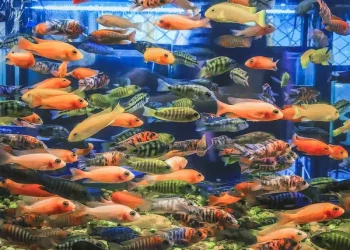Lungfish are a fascinating species of fish known for their unique ability to breathe air. Unlike most fish, which rely solely on their gills to extract oxygen from water, lungfish have a specialized lung that allows them to breathe air. In this article, we will explore how often lungfish need air, including their ability to regulate their breathing and their adaptations for survival in low-oxygen environments.
Breathing Patterns
Lungfish are able to breathe air through their specialized lungs, but they still require water to breathe. The frequency with which they need to breathe air and water depends on several factors, including their activity level and their environment. When lungfish are active, they require more oxygen and will breathe more frequently. When they are resting, they may breathe less frequently to conserve energy.
Lungfish are able to regulate their breathing in response to changes in their environment. For example, if they are in an environment with low oxygen levels, they will breathe more frequently to compensate for the lack of oxygen in the water. They are also able to adjust their breathing rate in response to changes in water temperature, which can affect their metabolism and oxygen requirements.
Surviving in Low-Oxygen Environments
Lungfish are adapted to survive in low-oxygen environments, such as dry riverbeds and swamps, where water is scarce. They are able to survive for extended periods of time by burrowing into the mud and entering a state of dormancy known as aestivation. During aestivation, lungfish slow down their metabolism and reduce their oxygen requirements. This allows them to conserve energy and survive until the next rain.
Lungfish are also able to survive in stagnant water that has low oxygen levels by using a specialized organ called the suprabranchial chamber. This organ is located above the gills and allows the lungfish to extract oxygen from air by gulping it at the surface of the water. The oxygen is then transferred to the bloodstream through blood vessels that run through the walls of the suprabranchial chamber.
Remarkable Adaptations
Lungfish have several remarkable adaptations that allow them to survive in low-oxygen environments. One of their most impressive adaptations is their ability to breathe air. This allows them to survive in water with low oxygen levels or to leave the water entirely and breathe air. Lungfish also have a specialized respiratory system that allows them to extract oxygen from air, which is essential for their survival in low-oxygen environments.
Another adaptation that helps lungfish to survive in harsh conditions is their ability to aestivate. During aestivation, lungfish can enter a state of dormancy that allows them to conserve energy and survive in dry environments for extended periods of time. They are also able to regenerate their tissues and organs, including their fins and even parts of their brain, which is a rare trait among vertebrates.
In conclusion, lungfish need air and water to survive, and the frequency with which they need to breathe depends on several factors, including their activity level and environment. They are able to regulate their breathing in response to changes in their environment, and are adapted to survive in low-oxygen environments by using specialized organs and entering a state of aestivation. Lungfish are one of the most unique and fascinating species of fish in the world, with remarkable adaptations that allow them to survive in harsh conditions and make them a subject of scientific curiosity and wonder.


























